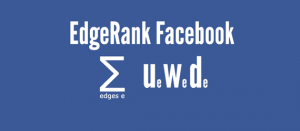![]() Some of, if not the most important parts of the web are the algorithms that make it run. Google’s search formula determines who shows up where in results, web crawlers are controlled by algorithms as they comb the web for information, and yes, social media uses them to make our online social life tick too.
Some of, if not the most important parts of the web are the algorithms that make it run. Google’s search formula determines who shows up where in results, web crawlers are controlled by algorithms as they comb the web for information, and yes, social media uses them to make our online social life tick too.
A word you may not be familiar with, but that has a huge impact on your online world is EdgeRank.
Most simply, EdgeRank is the algorithm Facebook uses to determine what you see in your Newsfeed. When you stop and think about that, it’s colossal importance to the social media world becomes clear. An algorithm that decides what we see and don’t see on the biggest social network on the planet? That’s the power EdgeRank has so we set out to learn a bit more about it.

“At a high level, the EdgeRank formula is fairly straightforward. But first, some definitions: every item that shows up in your News Feed is considered an Object. If you have an Object in the News Feed (say, a status update), whenever another user interacts with that Object they’re creating what Facebook calls an Edge, which includes actions like tags and comments.
Each Edge has three components important to Facebook’s algorithm:
- First, there’s an affinity score between the viewing user and the item’s creator — if you send your friend a lot of Facebook messages and check their profile often, then you’ll have a higher affinity score for that user than you would, say, an old acquaintance you haven’t spoken to in years.
- Second, there’s a weight given to each type of Edge. A comment probably has more importance than a Like, for example.
- And finally there’s the most obvious factor — time. The older an Edge is, the less important it becomes.”
What this essentially all boils down to is that the people you interact more with, will show up more in your feed. You may have noticed that you generally only get news about the friends you interact with the most online; you can thank EdgeRank for that. It’s goal is to make your feed more manageable and the information more relevant, but you can turn it off if you want. That way you can see news from everyone, including pages you like that you may not interact with often, but are still interested in keeping track of.
EdgeRank has spawned what people are calling NFO or News Feed Optimization. Similar to the idea of SEO, NFO is being implemented by brands looking to become more visible to the people in their network. Just like using knowledge of Google’s search formula, Facebookers are looking to boost the reach of their posts by utilizing the ideas behind what makes EdgeRank work.
If you’re looking to boost your visibility on Facebook, check out these 5 awesome tips! You can also look up your approximate EdgeRank for a page you are an Administrator on, at EdgeRank Checker.